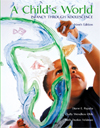Diane E. Papalia,
University of Wisconsin-Madison
Sally Wendkos Olds
Ruth Duskin Feldman
| alleles | paired genes (alike or different) that affect a trait.
|
 |
 |
 |
| autism | pervasive developmental disorder of the brain; characterized by lack of normal social interaction, impaired communication and imagination, and repetitive, obsessive behaviors.
|
 |
 |
 |
| autosomes | the 22 pairs of chromosomes not related to sexual expression.
|
 |
 |
 |
| behavioral genetics | quantitative study of relative hereditary and environmental influences.
|
 |
 |
 |
| canalization | limitation on variance of expression of certain inherited characteristics.
|
 |
 |
 |
| chromosomes | coils of DNA that carry the genes
|
 |
 |
 |
| clone | (verb) to make a genetic copy of an individual; (noun) a genetic copy of an individual
|
 |
 |
 |
| concordant | term describing twins who share the same trait or disorder.
|
 |
 |
 |
| deoxyribonucleic acid (DNA) | chemical that carries inherited instructions for the formation and function of body cells.
|
 |
 |
 |
| dizygotic(two-egg) twins | twins conceived by the union of two different ova (or a single ovum that has split) with two different sperm cells; also called fraternal twins.
|
 |
 |
 |
| dominant inheritance | pattern of inheritance in which, when a child receives contradictory alleles, only the dominant one is expressed.
|
 |
 |
 |
| down syndrome | chromosomal disorder characterized by moderate-to-severe mental retardation and a downward sloping skin fold at the inner corner of the eyes.
|
 |
 |
 |
| fertilization | union of sperm and ovum fuse to produce a zygote; also called conception
|
 |
 |
 |
| genes | small segments of DNA located in definite positions on particular chromosomes
|
 |
 |
 |
| genetic code | sequence of base pairs within DNA, which determine inherited characteristics.
|
 |
 |
 |
| genotype | genetic makeup of a person, containing both expressed and unexpressed characteristics.
|
 |
 |
 |
| genotype environment correlation | tendency of certain genetic and environmental influences to reinforce each other ; may be passive, reactive, (evocative), or active. Also called genotype-environment covariance.
|
 |
 |
 |
| genotype-environment interaction | the portion of phenotypic variation that results from the reactions of genetically different individuals to similar environmental conditions.
|
 |
 |
 |
| heritability | statistical estimate of contribution of heredity to individual differences in a specific trait within a given population.
|
 |
 |
 |
| heterozygous | possessing differing alleles for a trait.
|
 |
 |
 |
| homozygous | possessing two identical alleles for a trait.
|
 |
 |
 |
| human genome | complete sequence or mapping of genes in the human body and their locations.
|
 |
 |
 |
| infertility | inability to conceive after 12 to 18 months of trying.
|
 |
 |
 |
| monozygotic (one-egg) twins | twins resulting from the division of a single zygote after fertilization; also called identical twins.
|
 |
 |
 |
| multifactorial transmission | combination of genetic and environmental factors to produce certain complex traits.
|
 |
 |
 |
| mutations | permanent alterations in genes or chromosomes that may produce harmful characteristics.
|
 |
 |
 |
| natural selection | according to Darwin's theory of evolution, process by which characteristics that promote survival of a species are reproduced in successive generations, and characteristics that do not promote survival die out.
|
 |
 |
 |
| niche picking | tendency of a person, especially after early childhood, to seek out environments compatible with his or her projects.
|
 |
 |
 |
| nonshared environmental effects | tendency of a person, especially after early childhood, to seek out environments compatible with his or her genotype.
|
 |
 |
 |
| obesity | extreme overweight in relation to age, sex, height, and body type; sometimes defined as having a mass body index (weight-for-height) at or above the 85th or 95th percentile of growth curves for children of the same age and sex.
|
 |
 |
 |
| phenotype | observable characteristics of a person.
|
 |
 |
 |
| quantitative trait loci (QLT) | interaction of multiple genes each with affects of varying size, to produce a complex trait.
|
 |
 |
 |
| reaction range | potential variability, depending on environmental conditions, in the expression of a hereditary trait.
|
 |
 |
 |
| recessive inheritance | pattern of inheritance in which a child receives identical recessive alleles, resulting in expression of a nondominant trait.
|
 |
 |
 |
| schizophrenia | mental disorder marked by loss of contact with reality; symptoms include hallucinations and delusions.
|
 |
 |
 |
| sex chromosomes | pair of chromosomes that determines sex XX in the normal female, XY in the normal male.
|
 |
 |
 |
| sex-linked inheritance | pattern of inheritance in which certain characteristics carried on the X chromosome inherited from the mother are transmitted differently to her male and female offspring.
|
 |
 |
 |
| temperament | characteristic disposition, or style of approaching and reacting to situations.
|
 |
 |
 |
| zygote | one-celled organism resulting from fertilization
|



 2002 McGraw-Hill Higher Education
2002 McGraw-Hill Higher Education